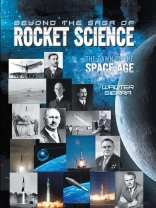The Dawn of the Space Age takes you on a fascinating journey into our space past. You’ll experience what rocket pioneers had to go through to develop today’s rockets, missiles, and space vehicles. In bringing to life the drama and complex interplay among scientists, engineers, and politicians that gave birth to the launch vehicles and spacecraft we take for granted today, The Dawn of the Space Age harnesses surrounding events as never before: political maneuvering, the drama of spies and counterspies, the feelings that key characters—all of whom are real—experienced, the society and political structure, life-changing crises, and more. You’ll be taken behind the scenes and come away with an understanding underlying what happened, what caused it to happen, and what nearly happened.
This highly informative book begins with exciting tales of the earliest developers of rudimentary rockets and the deadly battles they fought in China between 200 and 1600 A.D. A historical fiction approach brings long-ago characters and events to life. The tremendous achievements of the Wright Brothers — Wilbur and Orville — in the early 1900s serve as a useful backdrop for showcasing the difficulties involved in developing completely new technologies for practical use. The ingenious Dr. Robert Goddard, widely acknowledged as the inventor of the modern rocket, developed a sound theory in the 1910s and conducted pioneering flight tests in the 1920s and 1930s, while overcoming many failures. World War II gave the biggest impetus ever to advancing rocket science and related technologies. The book describes how the German V2, Soviet Soyuz, and American Corporal rockets paved the way for the design, fabrication, and operation of more refined, sophisticated second and third-generation missile systems that followed. In the ensuing decades many unsung space heroes on both sides of the Iron Curtain matured the field to where it is today. Led by the indomitable Sergei Korolyov, the Soviet Union captured an early lead over their archrival superpower during the Cold War, and achieved an embarrassing (for the United States) plethora of civilian space firsts. In the U.S., Dr. Wernher von Braun led the American space program during the crucial decades of the 1950s-1960s. He did more than anyone else in America to advance missiles, rockets, spaceflight; and made the manned landings on the moon possible. Von Braun led America’s race to the Moon, including the precursor Mercury Program, the Gemini Program, and finally the Apollo Program which landed 12 men on the Moon and returned over 835 pounds (379 kg) of moon rocks to the Earth.
Содержание
Series Introduction
Introduction
Rockets: The Beginning in China
Battle of Chengang
Emperor Xiaowu
Battle of Kaifeng
Qi Jiguang
Wan-Hu
Orville Wright
December 17, 1903
Samuel Pierpont Langley
Buzzard A Wreck
The Learning Years
The Art of Flying
Era of Patent Lawsuits
About Technology
NACA
The Wright Brothers’ Legacy
Robert Goddard
March 16, 1926
The Cherry Tree
The University Years
The Building Years
Primer on Rocket Basics and Terminology
Of Romance and Marriage
Westward Ho!
The Competition
The Demise of the ‘Lone Ranger’
Theodore von Kármán
Tacoma Narrows Bridge
Inquiry
The Early Years
Ludwig
Aachen
External Aerodynamics
Unveiling The Mystery of Turbulence
The Boss
The Rocketeers
JATO
The Aerospace Pioneers
Private, Corporal, Sergeant
Scientific Advisory Board
NATO
AEDC
Sergei Korolev
Dawn of The Space Age
Beating The Americans
Rocketeering Under Stalin’s Boot
The Great Leap Forward
East Versus West
Unbelievable Finds
The People
A Close Call
The Building Years
Shrouded in Secrecy
From Dictatorship To Totalitarianism
World’s First Nuclear Death Missile
Rise to Greatness
August 21, 1957
The Problem of Reentry Heating
Wernher von Braun
February 20, 1962
America Gets Its Space Hero
A Genius
Kummersdorf
The German Aggregate Rockets
July 27, 1934
Peenemünde
The V-1 Flying ‘Buzz Bomb’
A-4 Steps to Development
V-2 Development
V-2 Production
Effectiveness of the V-1 and V-2 as Weapons of War
Nazi Dream Weapons
Surface-To-Air Missiles
Air-Launched Missiles
SLBMS
Multistage Aggregate Vehicles
Operation Paperclip
Interlude at Fort Bliss
A Fresh Start
America Makes A Comeback
Vanguard
Explorer
NASA Takes Shape
NASA Pushes Forward with Project Mercury
Project Gemini
Acronyms and Glossary of Key Terms
Acknowledgements and Credits
Index
Об авторе
Prolific author and space transportation systems expert with 45+ years of progressive experience in systems engineering and integration of aerospace and defense systems, systems analysis and trade studies, formulation of system requirements, verification, and validation. Walter Sierra has worked in a variety of assignments from staff engineer to branch supervisor, in locations from major rocket firms in California to the halls of the Pentagon in Washington, D.C., and many places in between. Author of a four-book series (2021) entitled Beyond the Saga of Rocket Science which is easily readable for those interested in the history of the world’s space programs: (1) The Dawn of the Space Age, (2) Avoiding Armageddon, (3) In Space To Stay, (4) The Never-Ending Frontier. These books have received excellent reviews by Kirkus Reviews, the US Review of Books, Foreword Clarion Reviews, Pacific Book Review, and Blue Ink Review. Author Website: https://www.waltersierra.com












